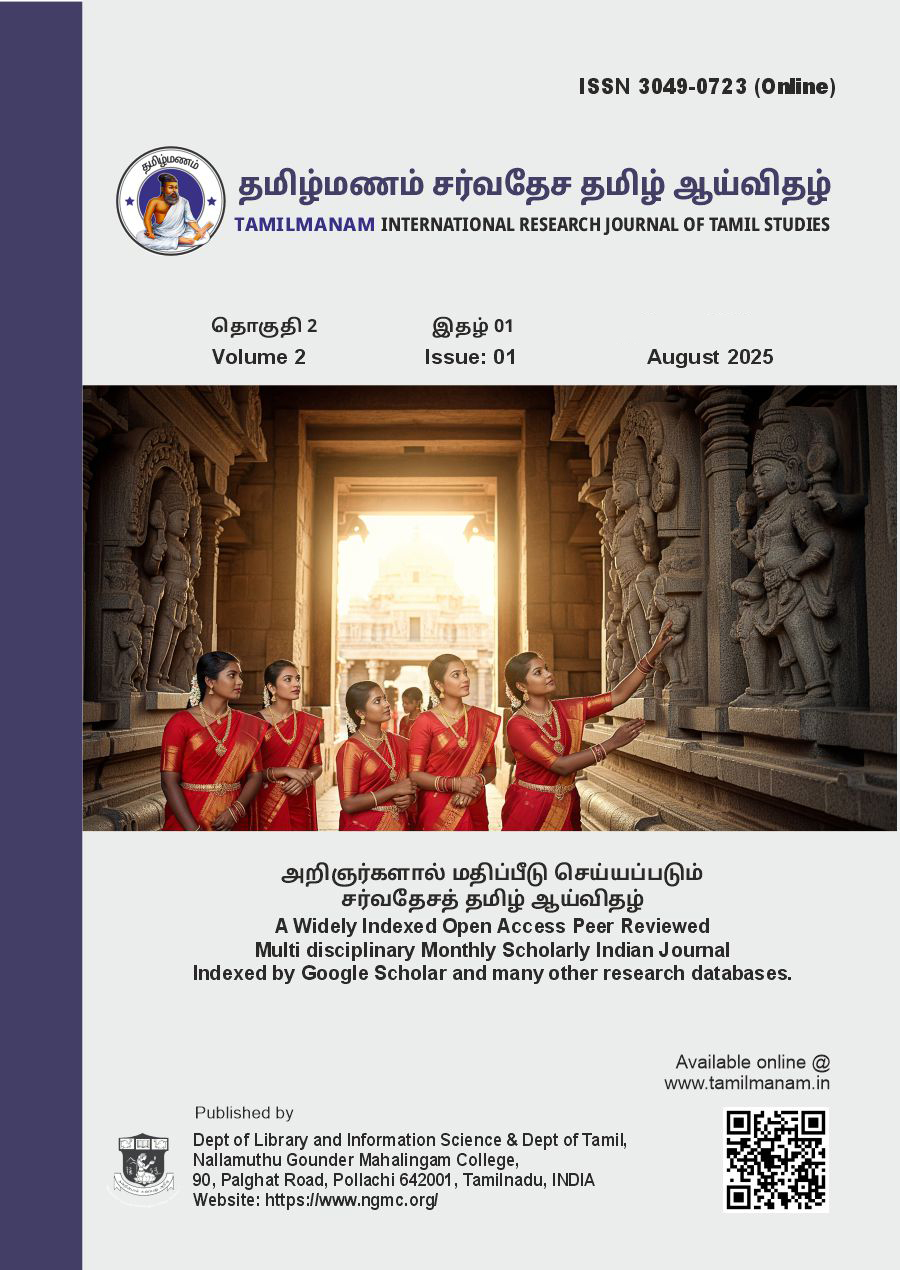Thirukkural as a Jain Philosophical Work
திருக்குறள் ஒரு சமணத் தத்துவப் படைப்பாக
Keywords:
Thirukkural, Thiruvalluvar, Jainism, Samyak Charitra, Sanskrit Linguistics, Kural Venpa, Tirthankara, Ahimsa, Moksha, Jain Numerology, Jain Cosmology, Tamil Literature, Bhakti-era redactions, Sangam Period, Silapathikaram, Ethical treatise, VirtuesAbstract
We demonstrate through textual, mathematical, and historical analysis that the Thirukkural, a renowned Tamil ethical treatise comprising of 1330 couplets and traditionally attributed to the poet-saint Thiruvalluvar, is an incomplete Jain philosophical work, originally comprising 2664 couplets across six sections (Aram, Porul, Inbam, Jnanam, Darshanam, and Moksham) plus four capstone couplets. Unified by samyak charitra (right conduct) and intricate numerical symbolism (e.g., 2664 ÷ 4 = 666, 2ⁿ −7 = x²) aligns with Jain numerology and cosmology, its truncation is attributed to British Conspiracy, led by two britishers, One Mr. George Harrington and other Mr. Francis Whyte Ellis (1777 – 1819), a British Civil Servant in the Madras Presidency and a scholar of Tamil and Sanskrit. The text’s structure reflects Jain mathematical precision, evident in a hypothesized 4+3 shift pattern—where couplets 9 (a square number, 3²) and 5 shift upward by 4 and 3 places, respectively, in each chapter’s reordering—ensuring thematic continuity across all 133 chapters and mirroring the kural venpa meter. The lost symmetry of Tirukkural’s philosophical structure is also decoded. All this numerical designs, alongside linguistic foundations in Sanskrit terms like Aadhi (“first”), Bhaga (“divine glory”), and the -van suffix (“possessing”), as seen in Bhagavān (“primal enlightened one”), aligns with Jain principles and the 24 Tirthankaras, 3 jewels, and 4 gatis. Crafted by Jain monks during the Sangam period (300 BCE–500 CE) for Tamil Nadu’s adivasi communities, the Tirukkural is “Voices of Virtue,” with “Thiruvalluvar” a Tirthankara-like title. Evidence includes textual analysis (ahimsa in Kurals 251, 324), Silappathikaram parallels, historical inscriptions, Jain numerical motifs, and the linguistic precision of divine epithets, challenging Hindu and secular interpretations (Mahadevan 2003; Jaini 1979).
Downloads
References
Ariel, M. Kural. Paris: UNESCO, 1979.
Balbir, Nalini. Jaina Epistemology. New Delhi: Motilal Banarsidass, 2019.
Barfield, T., trans. Ratnakaranda Sravakachara. New York: Jain Publishing, 2007.
Bothara, S., trans. Sutra Kritanga. Jaipur: Prakrit Bharati Academy, 2004.
Chakravarti, A. Jain Literature in Tamil. Madras: Jain Siddhanta Bhawan, 1941.
Champakalakshmi, R. Jainism in South India. Delhi: Oxford University Press, 1998.
Drew, W.H., and J. Lazarus, trans. Tirukkural with Parimelazhagar’s Commentary. Madras: Christian Literature Society, 1893.
Gopalakrishnamachariar, V.M., trans. Silappathikaram. Madras: South India Saiva Siddhanta Works, 1990.
Hardy, Friedhelm. Viraha-Bhakti: The Early History of Krsna Devotion in South India. Delhi: Oxford University Press, 1983.
Jacobi, H., trans. Kalpa Sutra. London: Trübner, 1884.
Jain, N., trans. Dravyasamgraha. Mumbai: Hindi Granth Karyalay, 2013.
Jaini, Padmanabh S. The Jaina Path of Purification. Berkeley: University of California Press, 1979.
Mahadevan, Iravatham. Early Tamil Epigraphy: From the Earliest Times to the Sixth Century A.D. Cambridge, MA: Harvard University Press, 2003.
Nathamal, Muni. Jaina Mathematical Traditions. Mumbai: Jain Vishva Bharati, 2021.
Peterson, Indira V. Poems to Siva: The Hymns of the Tamil Saints. Princeton: Princeton University Press, 1989.
Pope, G.U., trans. The Tirukkural of Tiruvalluvar. London: W.H. Allen, 1886.
Robinson, E.J., trans. Naladiyar. Madras: Christian Knowledge Society, 1873.
Tatia, Nathmal, trans. Tattvarthasutra. San Francisco: HarperCollins, 1994.
Zvelebil, Kamil. Tamil Literature. Wiesbaden: Harrassowitz, 1975.
Downloads
Additional Files
Published
Issue
Section
License

This work is licensed under a Creative Commons Attribution 4.0 International License.
Our journal adopts CC BY License Creative Commons Attribution 4.0 International License http://Creativecommons.org//license/by/4.0/ . It allows using, reusing, distributing and reproducing of the original work with proper citation.


